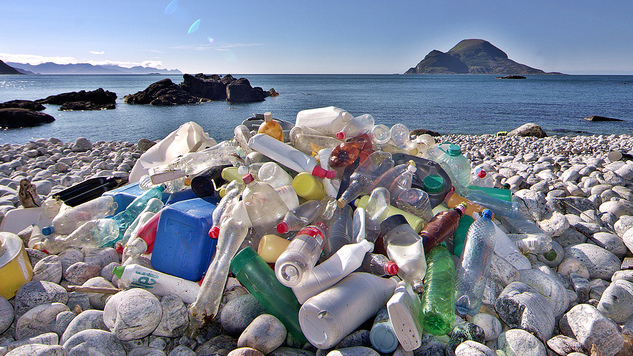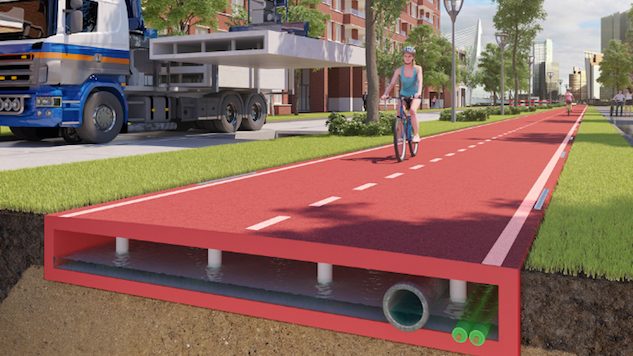The best innovations are often those that set out to solve for a simple problem and end up accomplishing much more. So goes the story of PlasticRoad, a Netherlands-based initiative that recycles plastic waste into lightweight modules that link together, Lego style, to build out roads with a remarkably smaller ecological footprint than asphalt. Inventors Anne Koudstaal and Simon Jorritsma began developing PlasticRoad in 2016 with the support of KWS, a subsidiary of VolkerWessels.
PlasticRoad isn’t the only cool kid on the block. India mixes plastic into asphalt roads as a way of reducing waste and carbon emissions. France just rolled out the world’s first solar powered road. What makes this project unique, however, is its all-encompassing simplicity, which demonstrates five possibilities for creating a greener future.
A New Vision for Plastic Waste
PlasticRoad began as a response to the many problems intrinsic to asphalt infrastructure. Roads flood. Sediment builds. Cables and pipes clutter overhead space, while those routed below ground require major roadwork to be accessed and repaired. The inventors envisioned a material that realigns water and sediment flow, creates easier access for repairs, and is environmentally friendly.
 Image by Bo Eide
Image by Bo Eide
Where did they start? With the enemy. Plastic waste—the same stuff that clogs our oceans, pollutes our air and contributes directly to global warming—was repurposed into configurable, lightweight modules. Each 4.8 × 3.5 meter module uses approximately 600 kilos of plastic, or roughly 66,139 bottles.
“If you have a plastic bottle,” Koudstaal said, “you only use it for one hour and throw it away, and after that it’s going to be burned. It’s a waste of all the energy that’s put into the plastic bottle and the materials that are used to create it.” In other words, the choice of material solves for two problems at once: it offers a cleaner solution to asphalt, while decluttering the planet.
A More Versatile Approach to Roadway Infrastructure
Hollow modules create a flowspace for water that acts as a coolant while reducing flooding. They also permit cables and pipes to pass through, thereby bypassing the more traditional overhauls of infrastructure. The modules can be recycled every 30-50 years, ad nauseam, contributing to a circular economy. PlasticRoad is also “future-proofed,” Koudstaal explained. “If someone has a bright idea that [requires] the space beneath the road,” they can remove an element of the road, make an installation, and reinsert the module—with minimal road work and the resultant traffic delays.
Support for Other Sustainable Alternatives
This design element means that, in the future, electric cars can be powered by the roadways themselves, further reducing fossil fuel consumption. Indeed, PlasticRoad could even someday harness the kinetic energy produced by vehicles driving on the road in order to further a cyclical energy process. “Think of the sustainable dance floor in Rotterdam,” said Koudstaal. When danced upon, “the movements produce energy that are used for lighting up the floor. This is also a possibility with PlasticRoad.”
Lower Temperatures and Greenhouse Emissions
Besides (possibly) lighting up like a disco floor, PlasticRoad uses a lighter color palette to deliberately reduce heat absorption. This helps to minimize the “urban heat island effect:” when roadways absorb the sun’s heat and radiate it back outwards, a major contributor to global warming. The modules can withstand temperatures ranging from -40 to 80 degrees Celsius, a far more flexible range than that of asphalt. And because the material is sourced locally from recycling centers—or essentially any plastic waste—“there is 80 percent less transport [involved] for PlasticRoad than for asphalt.” The lightweight design promises to ease the burden of transportation endeavors, while making it easier to configure for a variety of solutions.
An Inspiring Approach to Environmental Concerns
Initiatives such as these go beyond practical considerations. They inspire hope by exemplifying a creative, holistic response to a problem that, with a limited perspective, seems to fracture outward and grow ever worse. Global warming causes are vastly numbered: plastic in our oceans, CO2 emissions from vehicles and a static approach to transportation in general. Solutions like PlasticRoad deserve praise because they economize, simplify and even beautify our world with creative solutions that ingeniously solve several problems at once, while offering further inspiration to others. As Koudstaal said, “People are trying to think with you, which is really amazing to see. You get a lot of positive energy with it. It’s just a road, but it can do so much more. And if everyone sees it, it can go so far.”
Indeed, Swiss Railways are reportedly eager to adopt PlasticRoad into their stations. Homeowners want it for their driveway. A bike path in a to-be-determined-municipality of the Netherlands rolls out the end of this year.
PlasticRoad may not solve for all the world’s problems—but it certainly delivers a promising start.
Lead image by Marianne Muegenburg Cothern
Main image courtesy of PlasticRoad
Elisia Guerena is a Brooklyn based writer, who writes about tech, travel, feminism, and anything related to inner or outer space.

 Image by Bo Eide
Image by Bo Eide